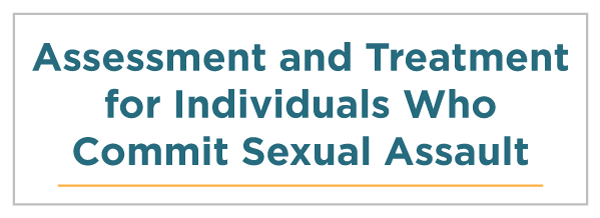
 |
 |
 |
 |
The majority of information related to sexual assault comes from victims. Multiple national surveys have documented the number of people who report being sexually assaulted as well as the impact of that assault.
These national surveys of victim experiences and of reported sexual assault have generated information about the people who perpetrated the assault. There is also a significant body of research about the adults and adolescents who have committed these sex crimes. Together, this information can build a more complete picture of what is known about these individuals.
The Sex Offender Management Assessment and Planning Initiative (SOMAPI) at the U.S. Department of Justice provides an in-depth overview of the national studies that have measured the incidence and prevalence of sexual assault and the implications for looking at rates of perpetration. [9]
Victims’ lived experiences, as well as the research on sex offenders, demonstrate there is no one profile or image for those who commit sexual assault. An offender can be a family member, partner, peer, child, acquaintance, or stranger to the victim. Someone who commits a sexual assault can be male, female, an adult, an adolescent, or a child.
Victims’ lived experience and sex offender research also demonstrates there are a variety of circumstances that surround sexual crimes. While some situations follow a distinct and similar pattern (e.g., some offenders will actively seek out vulnerable victims), the breadth and depth of sexual assault committed against victims demonstrates there is no easy way to categorize patterns. Furthermore, if one is focused on seeking to fit a crime into one of those patterns, it is possible to miss or dismiss an account of sexual assault because it does not fit into a preconceived notion of the crime.
Even with the wide variation in sexual assaults, data show some insights into who perpetrates sexual crimes:
These studies provide valuable insight into understanding this population and may also help SARTs make informed decisions about prevention, policies, and risk analysis.
Although there are no national surveys of offenders, there are a number of research studies that have been conducted in the United States on the prevalence of perpetration. Prevalence is defined as the number of people within a given group (e.g., men or women) who have sexually assaulted another person, while incidence means the number of separate sexual assaults (there can be multiple sexual assaults against the same person) committed by this group.
The Center for Disease Control and Prevention (CDC) recently conducted a preliminary review of the available prevalence data, which provides insights into this hidden and primarily (although not exclusively) male perpetrator population.
The research suggests that in a college sample of men, the percentage of males who acknowledged committing rape or attempted rape ranged from 6.4 percent to 13 percent. [16] When the questions were expanded to include the perpetration of any form of sexual misconduct, the samples of college males who engaged in this behavior ranged from 19.7 percent to 47 percent. [17]
In community samples, the percentage of males who acknowledged committing rape or attempted rape ranged from 6.4 percent to 24.5 percent. [18] When the questions were expanded to include a broader definition of sexual assault and misconduct, the percentage ranged from 22 percent to 64 percent. [19]
These studies are important to our understanding of the prevalence of sexual assault perpetration and focus attention on the individuals causing the harm.
Delving further into this research, a number of studies have found that a majority of those who acknowledged having raped or attempted rape admitted to having done so repeatedly. [20] Other studies have also identified a significant population of males who acknowledged multiple rapes over time, but also identified populations of males that did not continue to rape over time. [21] This data also reflects the more recent research on the different developmental trajectories for adolescents who have committed a sexual crime as well as the growing body of research on desistance (the cessation of offending).
While further research is needed, these studies begin to paint a picture of the broad diversity of men who commit sexual assault and their behaviors. Most importantly, together this research shows that a “one-size-fits-all approach” means we may miss information that is important to effective investigation and response to these adults or adolescents.
The etiology of sexual assault refers to the origins or causes of this behavior. There is no one single factor that contributes to an individual’s choice to commit sexual assault. [22] However, understanding the risk factors that are correlated with sexual violence perpetration can be helpful for both prevention and intervention efforts.
Research on adults points to a number of factors that put someone at a higher risk to commit a sexual assault, especially if multiple factors are present at the same time. There is also a growing body of research that addresses both the risk factors that can increase the likelihood that someone will commit a sexual assault and protective factors that can help reduce the risk of abusive behavior.
Research has found a number of risk factors for sexually abusive behaviors, such as — [23]
Chapter 2: Etiology of Adult Sexual Offending of the SOMAPI report provides a summary of factors that may put someone at higher risk to re-offend and the current etiological theories.
The research is clear that individuals who experience one or more of these risk factors are not necessarily at risk for a sexual offense. In other words, the presence of these risk factors does not determine that someone will perpetrate sexual assault. It is especially important to note that, while it is believed that sexual assault is often a learned behavior, other intervening factors influence whether sexually abusive behavior actually develops. As mentioned above, no one single factor will determine future sexually abusive behavior.
The CDC conducted a review of risk and protective factors for sexual violence perpetration [25] and identified factors for first-time perpetration at the individual and relationship levels that have strong support in research. As with the research described above, the CDC states that any one of these factors alone does not necessarily mean an individual will commit sexual assault. Further, strengthening protective factors can mitigate risk factors.
Individual risk factors identified by the CDC for first time perpetration include — [26]
Relationship factors include—
The protective factors identified in the research that build strengths and resilience and mitigate risk for both adult and adolescent sexual offending include—
For more information about protective factors regarding adolescent and adult sex offenders, see the February 2015 issue of Sexual Abuse: A Journal of Research and Treatment.
Understanding patterns of sexually abusive behavior and risk can help SARTs inform their decisions regarding investigation, as well as other professionals for the sentencing, treatment, and supervision of sex offenders.
Typological classification systems have been developed to explain and differentiate among the variations of sexual assault among adults, often based on the main motivations for and variations of sexual assault. These variations include the age, gender, access to and vulnerability of the victim, the degree of aggression used, sexual as well as nonsexual aspects of assaults, and the degree of self-control (impulsive vs. planned) in different sexual assault scenarios.
The most empirically tested typologies establish categories that include child sexual abusers, rapists, female offenders, and internet sex offenders. [28]
Adults who sexually abuse children are typically divided into categories:
The most important distinction among child sexual abusers is whether there is a pedophilic interest in children or youth. While pedophilia may not lead to sexual abuse, pedophilia is a stronger predictor in re-offense in someone who has already committed a sexual crime. [29]
Adults who sexually assault other adults are typically classified by their relationship to the victim:
Three out of four rapists know their victim and would be considered an acquaintance rapist. [30]
While females commit sexual assault, the rates are far lower, and the emerging typologies for women are also distinct. For example, most female typologies make distinctions based upon whether females assault with a co-offender (typically a male) or assault alone, often within the context of an acquaintance or position-of-trust relationship. [31]
Research on internet-facilitated sexual offending suggests there are key differences from other offenders; for example, adults who view child sexual abuse images reported more psychological difficulties in adulthood, are less likely to engage in sexually risky behaviors overall, and have fewer sexual convictions. [32]
However, it should be noted that as many as half of those who commit such crimes may also have a history of contact sex crimes. [33] Internet offenders have been classified into four groups: [34]
Typologies can be helpful in understanding those who commit sexual offenses, but it should be noted that over-simplification may not reflect the complexity and diversity of this population. For example, these typologies do not address the difference in working with a client with intellectual or developmental disabilities. For more information about typologies of sexual assault, see Chapter 3: Sex Offender Typologies of Adult Sexual Offending, in the Sex Offender Management Assessment and Planning Initiative.
Understanding the research about sexual assault recidivism can be helpful in understanding those who commit sexual crimes. Recidivism is defined as an individual committing a further crime, and that crime is reported to authorities, after receiving sanctions or intervention for a previous crime. There are limitations to the data, due to the underreporting of sexual assault and the fact that most sexual crimes are never recorded by the criminal justice system.
Research has identified information around sexual assault recidivism by adults:
Adolescents who commit sexual assault have significantly lower sexual recidivism rates than adults, ranging from 5 percent to 13 percent after 5 years, depending on the recidivism measure employed. [38] A recent study indicated that the sexual recidivism rate for studies between 2000 and 2015 (2.75 percent) was significantly lower than for studies between 1980 and 1995 (10.30 percent). The author suggests that the declining rates (73 percent lower) may be indicative of the field’s success in better addressing adolescent sexually abusive behavior. [39]
Research also shows adolescents convicted of a sexual offense have higher rates of general recidivism than sexual recidivism. [40] For this reason, interventions for adolescents should consider risk that is relevant to both nonsexual delinquency and sexual offenses. For more information on the recidivism of adolescents who have sexually assaulted, see the SOMAPI report. [41]
Research related to children with sexual behavior problems found the rate of further sexual behavior problems over a 10-year follow-up period was significantly lower for those who received treatment specific to the problem (2 percent) as compared to those who received play therapy (10 percent). [42]
| Back | Index | Next |
